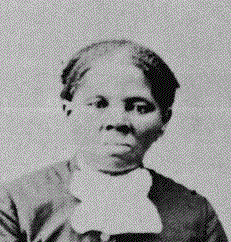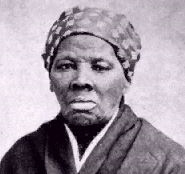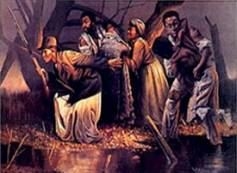 |
| Harriet Tubman |
Harriet Tubman was a black woman, born in Maryland into slavery in 1819 or 1820. Tubman freed herself, and later led more than 300 slaves up North to be free.
Who was Harriet Tubman? Harriet Tubman's name at birth was Araminta Ross. She was one of eleven children born into slavery in Dorchester County, Maryland. When she was a child, she was hired as a nursemaid for a small baby. Her job was to stay up all night, so the baby wouldn't cry and wake up the mother. If she fell asleep, the mother would whip her. Later, when Harriet was 12, she became a field-hand.
 |
| Harriet Tubman |
Harriet Tubman was born into slavery, and her parents were already slaves. She was raised under horrible conditions, and was whipped and beat regularly. Once, when she refused to tie up a young man who had gone to the store without permission, she was hit in the head, by the white man who had wanted to whip the other young slave, and major damage was inflicted. When the young man started to run away, the white man threw a heavy iron weight at him, but he missed him and hit Harriet instead. It put a huge indent in her head, and she suffered from seizures for the rest of her life. In 1844, when she was 25 years old, she received permission from her master to marry John Tubman, a free black man, and took his last name. She also changed her first name to Harriet, her mother's name. For the next five years, she lived in a state of semi-slavery. Legally, she was still a slave, but her master allowed her to live with her husband. In 1847, her master died, followed by the death of his son, in 1849. Fearing that she would be sold south, Harriet decided to escape. She moved to Pennsylvania. Despite Harriet’s attempts to persuade him to come with her, John Tubman remained in Maryland. Just two years later, she returned, to try to persuade him again. But, he had already remarried. Harriet did not marry again until after Tubman’s death.
 |
| Harriet Tubman |
Harriet decided to escape with her two brothers. They started by following the North Star towards freedom in the North. Partway there, her brothers became too frightened and turned back, but Harriet was determined, and kept on going. In Pennsylvania, she joined the abolitionist cause, a cause working to end slavery. It was there that she decided to become a conductor for the Underground Railroad.
The Underground Railroad was a secret network of houses which helped slaves journey to freedom. It was run by antislavery activists. In 1850, her first trip, Harriet Tubman brought her sister, and her sister’s two children out of slavery in Maryland. A year later, she rescued her brother, and in 1857, she returned to guide her aged parents to freedom. In just ten years, Tubman made about 19 expeditions into the South, and personally escorted about 300 slaves to freedom in Canada. The Fugitive Slave Law (of 1850), created federal commissioners in every county to return runaways. They dealt harsh punishments to the people who helped the slaves escape, too. Knowing she was a target for the law, she moved to St. Catharines, Ontario, Canada, in 1851. By the late 1850’s, some of the Northern states had created laws that protected the rights of fugitive slaves. Harriet purchased land and moved with her parents, to Auburn, New York, a center of antislavery. Her work guiding slaves was very dangerous, as Southerners offered large rewards for her capture. However, she used disguises brilliantly. When traveling in slave states, she sometimes posed as an old man, and sometimes as an old woman. She also always carried sleeping powder, to stop babies from crying, and a pistol, to prevent the fugitive slaves from backing out once the journey had begun. Tubman did not always take the same route, and was constantly changing her method of operation. But one thing never changed: she always began the journey on Saturday night, for two reasons: a) lots of masters didn’t make their slaves work on Sunday, so they wouldn’t notice they were missing until Monday, and b) newspapers that helped in catching the runaways were not published until the beginning of the week. Amazingly, Harriet Tubman never lost any slaves. Among African American slaves, she became known as “The Moses of her People,” after the hero who led the Hebrews of out enslavement in Egypt. She was also nick-named “General Tubman.”
 |
| Tubman leading slaves to freedom |
In the Civil War, 1861, Harriet Tubman was a nurse, scout, and spy for the Union Army in North Carolina. She didn’t get paid for her work, but she got an official commendation. In 1869, she married Nelson Davis, an African American war veteran. He died in 1890.
Harriet Tubman spent her later years continuing to improve the life of blacks. She raised funds to help former slaves, and even started a care facility at her own home which helped the elderly. She never learned to read or write, but her friend helped her write her biography.
Harriet Tubman is important to me because I think she proves that anything is possible, and I also think that it’s amazing that she dedicated her life to helping others. After getting free herself, she helped her family and friends to freedom, and then became part of the Underground Railroad to help the rest. She also made me realize that my problems are nothing, and that I shouldn’t be complaining. Harriet Tubman was very brave, and I really admire all the risks that she took. She helped hundreds, and inspired millions of people.
Page created on 4/11/2007 9:53:00 AM
Last edited 4/11/2007 9:53:00 AM
